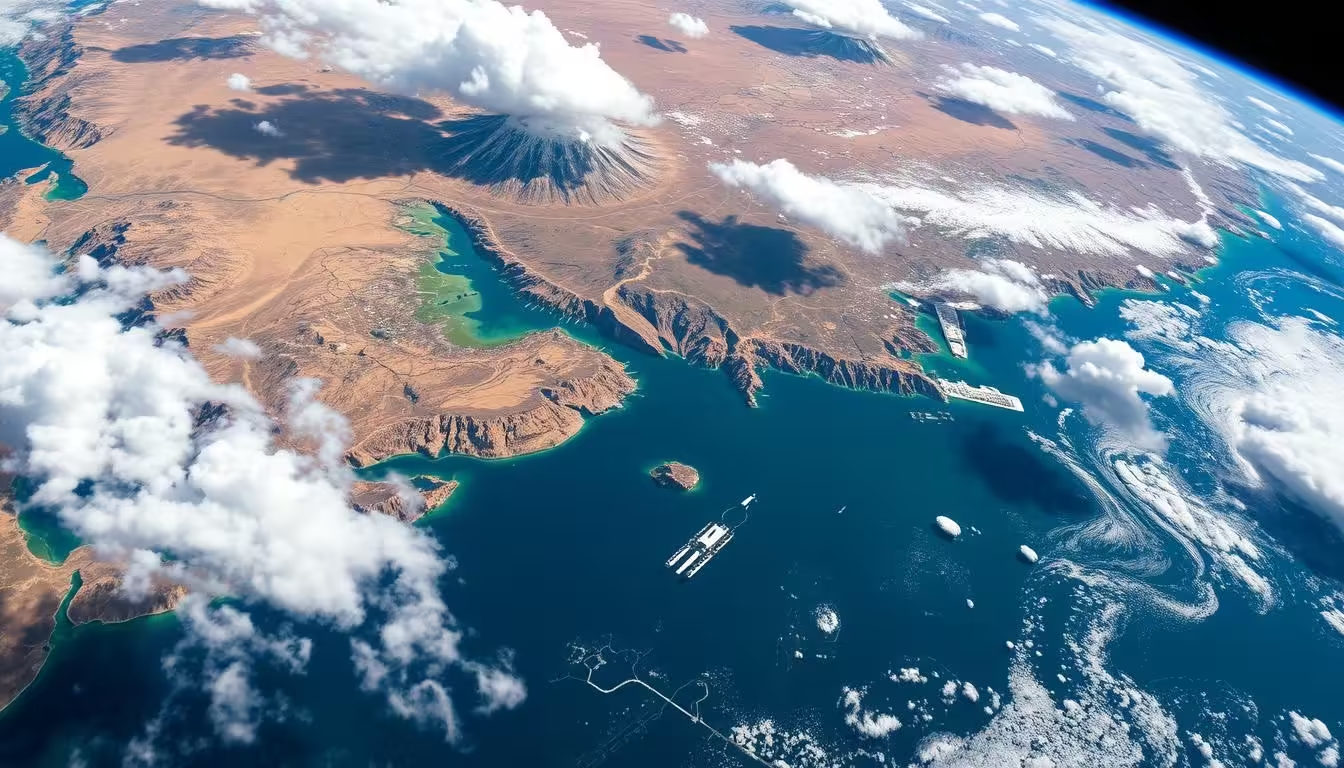Imagine being able to explore the world’s most breathtaking landscapes and vibrant cities from the comfort of your own home. With Google Earth, this is now possible. By harnessing the power of satellite imagery, Google Earth creates a stunning 3D map of our planet, allowing users to navigate and discover new places with ease.

This innovative tool not only provides a visually striking representation of the Earth but also offers a wealth of information about different locations around the globe. Whether you’re a curious traveler, a geography enthusiast, or simply someone who loves to explore, Google Earth is an invaluable resource that brings the world to your fingertips.
Key Takeaways
- Google Earth uses satellite imagery to create a 3D map of the world.
- The platform allows users to explore different locations globally.
- It provides a wealth of information about various geographical locations.
- Google Earth is useful for travelers, geography enthusiasts, and curious individuals.
- The tool brings the world to your fingertips, making exploration easy and accessible.
The Evolution of Google Earth: From Keyhole to Global Phenomenon
Google Earth’s journey to becoming a global phenomenon began with its origins in a company called Keyhole. Keyhole was a geospatial data visualization company that developed the technology that would eventually become Google Earth.
Origins and Acquisition by Google
Keyhole was founded in 2001 by John Hanke, and its software, known as Keyhole EarthViewer, allowed users to view and interact with 3D globes and satellite imagery. In 2004, Google acquired Keyhole, recognizing the potential of its technology to revolutionize the way people explore and understand the world.
The acquisition marked a significant turning point in the development of Google Earth, as Google’s resources enabled the expansion of Keyhole’s technology to a global audience.
Major Milestones in Development
Since its acquisition by Google, Google Earth has undergone numerous updates and enhancements. Some notable milestones include the release of Google Earth 5.0, which introduced historical imagery and a “Street View” layer, allowing users to see how places have changed over time.
Another significant development was the integration of 3D imagery, enabling users to explore cities and landscapes in greater detail. The table below highlights some of the major milestones in Google Earth’s development.
| Year | Milestone |
|---|---|
| 2001 | Keyhole founded |
| 2004 | Google acquires Keyhole |
| 2009 | Google Earth 5.0 released with historical imagery |
| 2014 | Google Earth introduces 3D imagery |

Behind the Technology: How Google Earth Creates Its 3D World
The 3D world of Google Earth is constructed using a vast array of satellite imagery and advanced mapping techniques. According to Google, “our 3D imagery is captured by specialized cameras on aircraft and satellites, providing a detailed view of the Earth’s surface.”

Satellite Imagery Collection Process
Google Earth collects satellite imagery from various sources, including commercial satellites and aerial photography. This process involves capturing images of the Earth’s surface from different angles and altitudes.
Photogrammetry and 3D Modeling Techniques
Photogrammetry is used to create 3D models from overlapping images. This technique involves analyzing the differences between images taken from different viewpoints to determine the height and depth of features.
As noted by experts, “photogrammetry is a crucial step in creating accurate 3D models of the Earth’s surface.”
Processing the Massive Data Sets
The vast amounts of data collected are processed using advanced algorithms and machine learning techniques. This processing involves stitching images together, removing clouds and other obstructions, and creating a seamless 3D model.
The result is a highly detailed and accurate representation of the Earth’s surface, available to users worldwide through Google Earth.
Exploring Earth and Technology Through Google’s Virtual Globe
The virtual globe technology of Google Earth offers an immersive experience, making global exploration accessible to everyone. This technology has transformed the way we interact with geographical data, providing a seamless and intuitive interface.
Navigation Tools and User Interface
Google Earth’s navigation tools are designed to be user-friendly, allowing users to easily explore different regions of the Earth. The interface is intuitive, with features such as zooming, tilting, and rotating, which enable a comprehensive view of any location. Users can also access historical imagery to observe changes over time.
Accessibility Features for Different Devices
Google Earth is accessible on a variety of devices, including desktops, laptops, tablets, and smartphones. This cross-platform compatibility ensures that users can explore the virtual globe from anywhere, at any time. The application’s responsive design adapts to different screen sizes, maintaining a consistent and engaging user experience.
By leveraging advanced technology and a user-centric design, Google Earth continues to make the world’s geography more accessible and engaging for a broad audience.
Google Earth’s High-Resolution Imagery: Seeing the World in Detail
The high-resolution satellite imagery on Google Earth is a powerful tool for both casual exploration and scientific research. It allows users to explore the world in remarkable detail, from the majesty of vast landscapes to the intricacies of urban environments.
Google Earth’s imagery is sourced from a variety of satellites and aerial photography, compiled to create a seamless and comprehensive view of the Earth’s surface. This compilation enables users to observe changes over time, track environmental shifts, and even monitor human activity.

Resolution Capabilities and Limitations
Google Earth’s resolution varies significantly depending on the location. Urban areas and regions of high interest often have resolutions as high as 15-30 cm per pixel, allowing for the identification of individual buildings, cars, and even people in some cases. However, more remote or less populated areas may have much lower resolutions, sometimes as low as 15-30 meters per pixel.
| Location Type | Typical Resolution | Example Features |
|---|---|---|
| Urban Areas | 15-30 cm/pixel | Buildings, cars, people |
| Rural Areas | 1-5 m/pixel | Fields, roads, large structures |
| Remote Areas | 15-30 m/pixel | Landforms, forests, large water bodies |
How Often Images Are Updated
The frequency of image updates on Google Earth varies. Major cities and areas of high interest are updated more frequently, sometimes as often as every few months. In contrast, more remote areas may be updated only every few years. Google uses a variety of sources, including its own satellites and those of its partners, to keep the imagery as current as possible.
Understanding the update frequency is crucial for applications that rely on the most current data, such as monitoring environmental changes or tracking urban development.
Beyond Sightseeing: Scientific Applications of Google Earth
With its vast repository of satellite imagery, Google Earth facilitates groundbreaking scientific discoveries. The platform’s extensive data has been harnessed by researchers across various disciplines, from archaeology to environmental science.
Archaeological Discoveries Made Possible
Google Earth has revolutionized the field of archaeology by providing high-resolution imagery that helps researchers identify potential dig sites and track changes in historical locations over time. Archaeologists use the platform to analyze landscapes, monitor site conditions, and even detect previously unknown ancient structures.

Urban Planning and Development Uses
Urban planners and developers utilize Google Earth to analyze and visualize urban growth patterns, plan infrastructure projects, and assess environmental impacts. The platform’s 3D modeling capabilities allow for detailed simulations of proposed developments, aiding in more informed decision-making processes.
Wildlife Conservation Applications
Conservationists leverage Google Earth to monitor wildlife habitats, track changes in ecosystems, and identify areas in need of protection. The platform’s imagery helps researchers study animal migration patterns, detect signs of habitat destruction, and implement effective conservation strategies. These efforts contribute to broader sustainability initiatives on our Earth.
Monitoring Climate Change and Environment Through Satellite Imagery
Google Earth’s satellite imagery plays a crucial role in monitoring climate change and its impacts on the environment. By analyzing changes in our planet’s surface over time, researchers and the general public can gain insights into various environmental issues.
Tracking Deforestation and Land Use Changes
One of the critical applications of Google Earth is tracking deforestation and land use changes. Satellite imagery allows for the monitoring of forest cover, enabling the detection of illegal logging activities and the assessment of conservation efforts.
Case Studies of Amazon Rainforest Monitoring
The Amazon Rainforest, often referred to as the “lungs of the Earth,” has been closely monitored using Google Earth’s satellite imagery. Studies have shown significant deforestation trends, highlighting the need for conservation efforts.
Quantifying Global Forest Loss
Global forest loss can be quantified using satellite data, providing valuable information on the rate and extent of deforestation. This data is crucial for policymakers and environmental organizations working to protect the world’s forests.
Visualizing Glacier Retreat and Sea Level Rise
Google Earth’s satellite imagery also enables the visualization of glacier retreat and sea level rise. By comparing images over time, the extent of glacier melting and its contribution to sea level rise can be assessed.

Documenting Natural Disasters and Recovery
Furthermore, Google Earth is used to document the impact of natural disasters such as hurricanes, wildfires, and tsunamis. Satellite imagery before and after these events helps in assessing damage and planning recovery efforts.
| Environmental Issue | Satellite Imagery Application | Benefits |
|---|---|---|
| Deforestation | Monitoring forest cover | Detection of illegal logging, assessment of conservation efforts |
| Glacier Retreat | Visualizing glacier changes | Understanding climate change impacts, assessing sea level rise |
| Natural Disasters | Documenting damage and recovery | Damage assessment, planning recovery efforts |
Google Earth Timelapse: Witnessing Decades of Environmental Transformation
By leveraging satellite imagery, Google Earth’s Timelapse feature reveals the dramatic changes in our planet’s landscape. This innovative technology allows users to witness decades of environmental transformation, providing a unique perspective on the dynamic nature of our world.

Compilation of Timelapse Imagery
The process of compiling Timelapse imagery involves gathering and processing vast amounts of satellite data. Google Earth uses a combination of satellite images taken at different times to create a visual representation of changes over time. This compilation is made possible through advanced technology that aligns and analyzes the images, creating a seamless timelapse sequence.
Notable Landscape Changes
Timelapse imagery has highlighted numerous significant environmental changes worldwide. For instance, the deforestation in the Amazon rainforest and the melting of glaciers in the Arctic are starkly illustrated through this technology. These visual representations not only raise awareness but also provide valuable data for researchers and conservationists.
As Dr. Jane Smith, an environmental scientist, notes, “Google Earth’s Timelapse feature is a powerful tool for understanding the pace and scale of environmental changes.”
Using Timelapse Data for Environmental Advocacy
The data provided by Google Earth’s Timelapse is invaluable for environmental advocacy. By visualizing changes in the landscape, activists and policymakers can better understand the impact of human activities on the environment. This information can be used to advocate for more sustainable practices and policies, ultimately contributing to the preservation of our planet.
“The ability to visualize environmental changes over time is crucial for developing effective conservation strategies,” says a representative from the
Environmental Defense Fund, a leading organization in environmental advocacy
.
Educational Impact: Google Earth in Classrooms and Research
The integration of Google Earth into educational curricula has opened new avenues for interactive learning and research. Google Earth’s vast repository of satellite imagery and 3D modeling capabilities makes it an invaluable tool for educators and researchers alike.
Classroom Applications and Learning Tools
Google Earth is being used in classrooms to enhance the learning experience. It provides students with a interactive platform to explore geography, environmental science, and history. For instance, students can use Google Earth to visualize the effects of climate change, explore historical sites, or understand complex geographical phenomena.
As Dr. Jane Smith, a geography educator, notes, “Google Earth has been a game-changer in our classrooms, allowing students to engage with complex concepts in a more tangible way.”
University Research Powered by Google Earth
At the university level, Google Earth is being used to facilitate cutting-edge research in various fields, including environmental science, archaeology, and urban planning. Researchers are using Google Earth’s satellite imagery to track environmental changes, identify archaeological sites, and analyze urban development patterns.
For example, a research team used Google Earth to study the impact of deforestation on local ecosystems. Their findings highlighted the importance of conservation efforts and demonstrated the potential of Google Earth as a tool for environmental research.
Sustainability and Green Tech Applications of Google Earth
The application of Google Earth in sustainability and green tech is revolutionizing how we approach environmental conservation. By leveraging its advanced mapping technology, Google Earth supports various initiatives aimed at promoting sustainability worldwide.
Renewable Energy Site Planning and Optimization
Google Earth is instrumental in identifying and optimizing sites for renewable energy projects. By analyzing topographical data and environmental factors, developers can use Google Earth to determine the most suitable locations for solar farms or wind turbines, thus enhancing the efficiency of renewable energy production.
Urban Green Space Analysis and Development
Urban green spaces play a crucial role in maintaining ecological balance within cities. Google Earth enables urban planners to analyze existing green spaces and identify areas where new parks or gardens can be developed. This not only improves air quality but also enhances the aesthetic appeal of urban environments.
Water Resource Management and Conservation
Effective water resource management is critical for sustainability. Google Earth facilitates the monitoring of water bodies, helping conservationists track changes in water levels, identify pollution sources, and implement measures to protect these vital resources.
| Application | Description | Benefit |
|---|---|---|
| Renewable Energy | Site planning and optimization | Increased efficiency |
| Urban Green Spaces | Analysis and development | Improved air quality |
| Water Resources | Monitoring and conservation | Protected water bodies |
Privacy and Security Considerations in Satellite Mapping
With the ability to capture and display high-resolution images of the Earth’s surface, satellite mapping raises significant privacy and security concerns. As services like Google Earth continue to evolve, it’s crucial to address these issues to ensure a balance between public access and security.
Blurring and Censorship Policies
To mitigate privacy and security risks, Google Earth has implemented blurring and censorship policies. For instance, sensitive locations such as military bases, government buildings, and certain private properties are blurred or censored to protect sensitive information.
| Location Type | Blurring/Censorship Policy |
|---|---|
| Military Bases | Blurred or Censored |
| Government Buildings | Blurred or Censored |
| Private Properties | Blurred upon request |
Balancing Public Access with Security Concerns
Balancing public access to satellite imagery with security concerns is a complex challenge. While Google Earth provides valuable information for educational, research, and recreational purposes, it also poses risks if sensitive information is not properly protected. Effective policies and technologies are needed to mitigate these risks.
The ongoing development of satellite mapping technologies necessitates a continuous review of privacy and security measures. By understanding the implications of these technologies and implementing appropriate safeguards, we can maximize their benefits while minimizing potential risks.
Conclusion: Google Earth’s Ongoing Impact on Our Understanding of the Planet
Google Earth has revolutionized our understanding of the planet, providing a powerful tool for exploring and protecting our world. By harnessing the power of satellite imagery and 3D modeling, Google Earth has made it possible to visualize and analyze the Earth’s surface in unprecedented detail.
The impact of Google Earth extends far beyond its role as a virtual globe, contributing significantly to sustainability and green tech initiatives. From monitoring climate change and deforestation to supporting urban planning and conservation efforts, Google Earth has become an indispensable resource for researchers, policymakers, and the general public.
As the technology continues to evolve, we can expect Google Earth to play an increasingly important role in promoting sustainability and environmental stewardship. By providing a platform for data-driven decision-making and global collaboration, Google Earth is helping to shape a more sustainable future for our planet.
With its commitment to updating and expanding its dataset, Google Earth remains a vital tool for anyone interested in understanding and protecting our world. As we move forward, it is clear that Google Earth’s contributions to sustainability and green tech will only continue to grow, empowering us to build a better future for generations to come.



